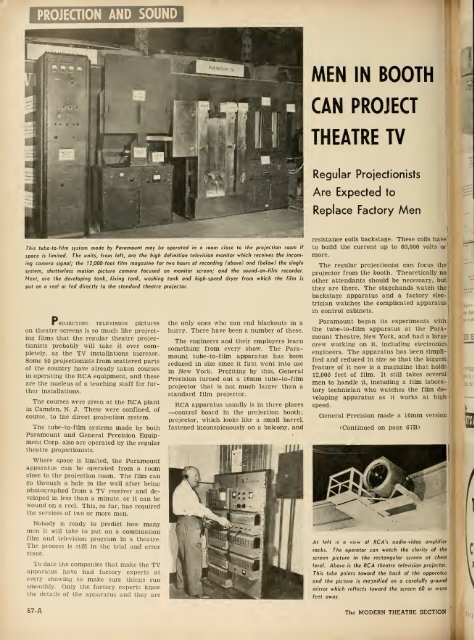You also want an ePaper? Increase the reach of your titles
YUMPU automatically turns print PDFs into web optimized ePapers that Google loves.
I<br />
PROJECTION AND SOUND<br />
MEN IN BOOTH ii<br />
CAN PROJECT<br />
d<br />
THEATRE TV<br />
i<br />
Regular Projectionists<br />
Are Expected to<br />
Replace Factory Men<br />
This tube-to-film system mode by Paramount may be operated in a room close to the projection room if<br />
space is limited. The units, from left, are the high definition television monitor which receives the incoming<br />
camera signal; the 12,000-foot film magazine for two hours of recording (above) and (below) the single<br />
system, shutterless motion picture camera focused on monitor screen; and the sound-on-film recorder.<br />
Next, are the developing tank, fixing tank, washing tank and high-speed dryer from which the film is<br />
put on a reel or fed directly to the standard theatre projector.<br />
resistance coils backstage.<br />
These coils have<br />
to build the current up to 60,000 volts or',<br />
more.<br />
,<br />
The regular projectionist can focus thej<br />
projector from the booth. Theoretically no'<br />
other attendants should be necessary, but<br />
they are there. The stagehands watch the<br />
rROJECTING TELEVISION pictuies<br />
on theatre screens is so much like projecting<br />
films that the regular theatre projectionists<br />
probably will take it over completely,<br />
as the TV installations increase.<br />
Some 50 projectionists from scattered parts<br />
of the country have already taken courses<br />
in operating the RCA equipment, and these<br />
are the nucleus of a teaching staff for further<br />
installations.<br />
The courses were given at the RCA plant<br />
in Camden, N. J. These were confined, of<br />
course, to the direct projection system.<br />
The tube-to-film systems made by both<br />
Paramount and General Pi-ecision Equipment<br />
Corp. also are operated by the regular<br />
theatre projectionists.<br />
Where space is limited, the Paramount<br />
apparatus can be operated from a room<br />
close to the projection room. The film can<br />
go through a hole in the wall after being<br />
photographed from a TV receiver and developed<br />
in less than a minute, or it can be<br />
wound on a reel. This, so far, has required<br />
the services of two or more men.<br />
Nobody is ready to predict how many<br />
men it will take to put on a combination<br />
film and television program in a theatre.<br />
The process is still in the trial and error<br />
stage.<br />
To date the companies that make the TV<br />
apparatus have had factory experts at<br />
every showing to make sure things run<br />
smoothly. Only the factory experts know<br />
the details of the apparatus and they are<br />
the only ones who can end blackouts in a<br />
hurry. There have been a number of these.<br />
The engineers and their employers learn<br />
something from every show. The Paramount<br />
tube-to-film apparatus has been<br />
reduced in size since it first went into use<br />
in New York. Profiting by this, General<br />
Precision turned out a 16mm tube-to-film<br />
projector that is not much larger than a<br />
standard film projector.<br />
RCA apparatus usually is in three places<br />
—control board in the projection booth;<br />
projector, which looks like a small barrel,<br />
fastened inconspicuously on a balcony, and<br />
backstage apparatus and a factory elec-<br />
•<br />
trician watches the complicated apparatus,<br />
in control cabinets.<br />
Paramount began its experiments with<br />
the tube-to-film apparatus at the Paramount<br />
Theatre, New York, and had a large<br />
crew working on it, including electronics<br />
engineers. The apparatus has been simplified<br />
and reduced in size so that the biggest<br />
•<br />
feature of it now is a magazine that holds<br />
;<br />
12,000 feet of film. It still takes several<br />
men to handle it, including a film laboratory<br />
technician who watches the film developing<br />
apparatus as it works at high<br />
j<br />
speed.<br />
;<br />
General Precision made a 16mm version<br />
(Continued on page 67B)<br />
At left IS a view of RCA's audio-video amplifier<br />
I<br />
racks. The operator can watch the clarity of the<br />
screen picture in the rectangular screen at chest '<br />
level. Above is the RCA theatre television projector.<br />
This tube points toward the back of the apparatus<br />
and the picture is mainified on a carefully ground<br />
mirror which reflects toward the screen 60 or more<br />
feet<br />
away.<br />
j<br />
67-A The MODERN THEATRE SECTION

















